Two Lineages of Papillomaviruses Identified from Caracals (Caracal caracal) in South Africa
Abstract
:1. Introduction
2. Materials and Methods
2.1. Study Site and Sample Collection
2.2. Sample Processing and Papillomavirus Genome Identification
2.3. Genome Characterization, Pairwise Comparison, and Phylogenetic Analyses
3. Results and Discussion
3.1. Identification of Papillomavirus Genomes in Wild Caracal
3.2. Caracal Mitochondrial Genomes
3.3. Sequence Comparison of Caracal PVs
3.4. Caracal PV L1 + E1 + E2 Phylogeny
3.5. Large Non-Coding Region in the Genomes of Lambdapapillomaviruses
3.6. E6 and E7 Protein Motifs
4. Conclusions
Supplementary Materials
Author Contributions
Funding
Institutional Review Board Statement
Informed Consent Statement
Data Availability Statement
Conflicts of Interest
References
- Frias-De-Diego, A.; Jara, M.; Escobar, L.E. Papillomavirus in Wildlife. Front. Ecol. Evol. 2019, 7, 406. [Google Scholar] [CrossRef]
- Van Doorslaer, K.; Chen, Z.; Bernard, H.U.; Chan, P.K.S.; DeSalle, R.; Dillner, J.; Forslund, O.; Haga, T.; McBride, A.A.; Villa, L.L.; et al. ICTV Virus Taxonomy Profile: Papillomaviridae. J. Gen. Virol. 2018, 99, 989–990. [Google Scholar] [CrossRef] [PubMed]
- Kraberger, S.; Austin, C.; Farkas, K.; Desvignes, T.; Postlethwait, J.H.; Fontenele, R.S.; Schmidlin, K.; Bradley, R.W.; Warzybok, P.; Van Doorslaer, K.; et al. Discovery of novel fish papillomaviruses: From the Antarctic to the commercial fish market. Virology 2022, 565, 65–72. [Google Scholar] [CrossRef] [PubMed]
- Van Doorslaer, K.; Li, Z.; Xirasagar, S.; Maes, P.; Kaminsky, D.; Liou, D.; Sun, Q.; Kaur, R.; Huyen, Y.; McBride, A.A. The Papillomavirus Episteme: A major update to the papillomavirus sequence database. Nucleic Acids Res. 2017, 45, D499–D506. [Google Scholar] [CrossRef]
- Smeele, Z.E.; Burns, J.M.; Van Doorsaler, K.; Fontenele, R.S.; Waits, K.; Stainton, D.; Shero, M.R.; Beltran, R.S.; Kirkham, A.L.; Berngartt, R.; et al. Diverse papillomaviruses identified in Weddell seals. J. Gen. Virol. 2018, 99, 549–557. [Google Scholar] [CrossRef] [PubMed]
- Padilla-Mendoza, J.R.; Gomez-Lopez, L.A.; Lopez-Casamichana, M.; Azuara-Liceaga, E.I.; Cortes-Malagon, E.M.; Lopez-Canovas, L.; Reyes-Hernandez, O.D.; Rodriguez, M.A.; Bonilla-Delgado, J.; Lopez-Reyes, I. Human Papillomavirus Coinfection in the Cervical Intraepithelial Lesions and Cancer of Mexican Patients. Biomed. Res. Int. 2020, 2020, 4542320. [Google Scholar] [CrossRef] [PubMed]
- Munday, J.S. Papillomaviruses in felids. Vet. J. 2014, 199, 340–347. [Google Scholar] [CrossRef] [PubMed]
- Sundberg, J.P.; Van Ranst, M.; Montali, R.; Homer, B.L.; Miller, W.H.; Rowland, P.H.; Scott, D.W.; England, J.J.; Dunstan, R.W.; Mikaelian, I.; et al. Feline papillomas and papillomaviruses. Vet. Pathol. 2000, 37, 1–10. [Google Scholar] [CrossRef] [PubMed]
- Munday, J.S.; Dunowska, M.; Hills, S.F.; Laurie, R.E. Genomic characterization of Felis catus papillomavirus-3: A novel papillomavirus detected in a feline Bowenoid in situ carcinoma. Vet. Microbiol. 2013, 165, 319–325. [Google Scholar] [CrossRef]
- Munday, J.S.; Dittmer, K.E.; Thomson, N.A.; Hills, S.F.; Laurie, R.E. Genomic characterisation of Felis catus papillomavirus type 5 with proposed classification within a new papillomavirus genus. Vet. Microbiol. 2017, 207, 50–55. [Google Scholar] [CrossRef]
- Tachezy, R.; Duson, G.; Rector, A.; Jenson, A.B.; Sundberg, J.P.; Van Ranst, M. Cloning and genomic characterization of Felis domesticus papillomavirus type 1. Virology 2002, 301, 313–321. [Google Scholar] [CrossRef] [PubMed]
- Dunowska, M.; Munday, J.S.; Laurie, R.E.; Hills, S.F. Genomic characterisation of Felis catus papillomavirus 4, a novel papillomavirus detected in the oral cavity of a domestic cat. Virus Genes 2014, 48, 111–119. [Google Scholar] [CrossRef] [PubMed]
- Carrai, M.; Van Brussel, K.; Shi, M.; Li, C.X.; Chang, W.S.; Munday, J.S.; Voss, K.; McLuckie, A.; Taylor, D.; Laws, A.; et al. Identification of A Novel Papillomavirus Associated with Squamous Cell Carcinoma in A Domestic Cat. Viruses 2020, 12, 124. [Google Scholar] [CrossRef] [PubMed]
- Lange, C.E.; Tobler, K.; Markau, T.; Alhaidari, Z.; Bornand, V.; Stockli, R.; Trussel, M.; Ackermann, M.; Favrot, C. Sequence and classification of FdPV2, a papillomavirus isolated from feline Bowenoid in situ carcinomas. Vet. Microbiol. 2009, 137, 60–65. [Google Scholar] [CrossRef] [PubMed]
- Munday, J.S.; Kiupel, M.; French, A.F.; Howe, L.; Squires, R.A. Detection of papillomaviral sequences in feline Bowenoid in situ carcinoma using consensus primers. Vet. Dermatol. 2007, 18, 241–245. [Google Scholar] [CrossRef] [PubMed]
- Graham, E.H.; Adamowicz, M.S.; Angeletti, P.; Clarke, J.; Fernando, S.; Herr, J.R. Genome Sequence of Feline Papillomavirus Strain P20 Assembled from Metagenomic Data from the Skin of a House Cat Owner. Microbiol. Resour. Announc. 2022, 11, e0107021. [Google Scholar] [CrossRef] [PubMed]
- Munday, J.S.; Gedye, K.; Knox, M.A.; Pfeffer, H.; Lin, X. Genetic characterisation of Felis catus papillomavirus type 7, a rare infection of cats that may be associated with skin cancer. Vet. Microbiol. 2023, 284, 109813. [Google Scholar] [CrossRef] [PubMed]
- Munday, J.S.; Thomson, N.A. Papillomaviruses in Domestic Cats. Viruses 2021, 13, 1664. [Google Scholar] [CrossRef]
- Munday, J.S.; Thomson, N.; Dunowska, M.; Knight, C.G.; Laurie, R.E.; Hills, S. Genomic characterisation of the feline sarcoid-associated papillomavirus and proposed classification as Bos taurus papillomavirus type 14. Vet. Microbiol. 2015, 177, 289–295. [Google Scholar] [CrossRef]
- Rector, A.; Lemey, P.; Tachezy, R.; Mostmans, S.; Ghim, S.J.; Van Doorslaer, K.; Roelke, M.; Bush, M.; Montali, R.J.; Joslin, J.; et al. Ancient papillomavirus-host co-speciation in Felidae. Genome Biol. 2007, 8, R57. [Google Scholar] [CrossRef]
- Sundberg, J.P.; Montali, R.J.; Bush, M.; Phillips, L.G.; O’Brien, S.J.; Jenson, A.B.; Burk, R.D.; Van Ranst, M. Papillomavirus-Associated Focal Oral Hyperplasia in Wild and Captive Asian Lions (Panthera leo persica). J. Zoo Wildl. Med. 1996, 27, 61–70. [Google Scholar]
- Dolz, G.; Lecis, R.; Solorzano-Morales, A.; Aguilar-Vargas, F.; Solorzano-Scott, T.; Pena, R.; Zobba, R.; Tore, G.; Pittau, M.; Alberti, A. Leopardus wiedii Papillomavirus type 1, a novel papillomavirus species in the tree ocelot, suggests Felidae Lambdapapillomavirus polyphyletic origin and host-independent evolution. Infect. Genet. Evol. 2020, 81, 104239. [Google Scholar] [CrossRef] [PubMed]
- Steenkamp, G.; Tordiffe, A.S.W.; Suleman, E.; Oosthuizen, A.; Brettschneider, H.; Boy, S.C. Sublingual papillomas of cheetahs in southern Africa. Vet. Pathol. 2022, 59, 997–1002. [Google Scholar] [CrossRef] [PubMed]
- Johansson, O.; Ullman, K.; Lkhagvajav, P.; Wiseman, M.; Malmsten, J.; Leijon, M. Detection and Genetic Characterization of Viruses Present in Free-Ranging Snow Leopards Using Next-Generation Sequencing. Front. Vet. Sci. 2020, 7, 645. [Google Scholar] [CrossRef] [PubMed]
- Womble, M.; Georoff, T.A.; Helmick, K.; Carpenter, N.A.; Joslin, J.; Tupa, L.; Tetzloff, J.; McAloose, D. Mortality Review for the North American Snow Leopard (Panthera Uncia) Zoo Population from January 1999 to December 2019. J. Zoo Wildl. Med. 2021, 52, 145–156. [Google Scholar] [CrossRef] [PubMed]
- Munday, J.S.; Knight, C.G.; Howe, L. The same papillomavirus is present in feline sarcoids from North America and New Zealand but not in any non-sarcoid feline samples. J. Vet. Diagn. Investig. 2010, 22, 97–100. [Google Scholar] [CrossRef] [PubMed]
- Ito, S.; Chambers, J.K.; Mori, C.; Sumi, A.; Omachi, T.; Nakayama, H.; Uchida, K. Comparative In Vitro and In Vivo Studies on Feline, Canine, and Human Merkel Cell Carcinoma. Vet. Pathol. 2021, 58, 276–287. [Google Scholar] [CrossRef] [PubMed]
- Alberti, A.; Tore, G.; Scagliarini, A.; Gallina, L.; Savini, F.; Caporali, C.; Abramo, F. Regressing Multiple Viral Plaques and Skin Fragility Syndrome in a Cat Coinfected with FcaPV2 and FcaPV3. Case Rep. Vet. Med. 2015, 2015, 469317. [Google Scholar] [CrossRef]
- Chu, S.; Wylie, T.N.; Wylie, K.M.; Johnson, G.C.; Skidmore, Z.L.; Fleer, M.; Griffith, O.L.; Bryan, J.N. A virome sequencing approach to feline oral squamous cell carcinoma to evaluate viral causative factors. Vet. Microbiol. 2020, 240, 108491. [Google Scholar] [CrossRef]
- Yamashita-Kawanishi, N.; Sawanobori, R.; Matsumiya, K.; Uema, A.; Chambers, J.K.; Uchida, K.; Shimakura, H.; Tsuzuki, M.; Chang, C.Y.; Chang, H.W.; et al. Detection of felis catus papillomavirus type 3 and 4 DNA from squamous cell carcinoma cases of cats in Japan. J. Vet. Med. Sci. 2018, 80, 1236–1240. [Google Scholar] [CrossRef]
- Munday, J.S.; Peters-Kennedy, J. Consistent detection of Felis domesticus papillomavirus 2 DNA sequences within feline viral plaques. J. Vet. Diagn. Investig. 2010, 22, 946–949. [Google Scholar] [CrossRef]
- Zhao, M.; Yue, C.; Yang, Z.; Li, Y.; Zhang, D.; Zhang, J.; Yang, S.; Shen, Q.; Su, X.; Qi, D.; et al. Viral metagenomics unveiled extensive communications of viruses within giant pandas and their associated organisms in the same ecosystem. Sci. Total Environ. 2022, 820, 153317. [Google Scholar] [CrossRef]
- Munday, J.S.; French, A.F.; Gibson, I.R.; Knight, C.G. The presence of p16 CDKN2A protein immunostaining within feline nasal planum squamous cell carcinomas is associated with an increased survival time and the presence of papillomaviral DNA. Vet. Pathol. 2013, 50, 269–273. [Google Scholar] [CrossRef]
- Kok, M.K.; Yamashita-Kawanishi, N.; Chambers, J.K.; Haritani, M.; Ushigusa, T.; Haga, T.; Nakayama, H.; Uchida, K. Pathologic characterization of Felis catus papillomavirus type 5 (FcaPV-5)-associated viral plaques and Bowenoid in situ carcinoma in a Domestic Shorthair cat. J. Vet. Med. Sci. 2019, 81, 660–666. [Google Scholar] [CrossRef] [PubMed]
- Munday, J.S.; Hunt, H.; Orbell, G.; Pfeffer, H. Detection of a Novel Papillomavirus Type within a Feline Cutaneous Basal Cell Carcinoma. Vet. Sci. 2022, 9, 671. [Google Scholar] [CrossRef] [PubMed]
- Munday, J.S.; Kiupel, M.; French, A.F.; Howe, L. Amplification of papillomaviral DNA sequences from a high proportion of feline cutaneous in situ and invasive squamous cell carcinomas using a nested polymerase chain reaction. Vet. Dermatol. 2008, 19, 259–263. [Google Scholar] [CrossRef]
- Munday, J.S.; Knight, C.G.; French, A.F. Evaluation of feline oral squamous cell carcinomas for p16CDKN2A protein immunoreactivity and the presence of papillomaviral DNA. Res. Vet. Sci. 2011, 90, 280–283. [Google Scholar] [CrossRef] [PubMed]
- Anis, E.A.; Frank, L.A.; Francisco, R.; Kania, S.A. Identification of canine papillomavirus by PCR in Greyhound dogs. PeerJ 2016, 4, e2744. [Google Scholar] [CrossRef]
- Munday, J.S.; Hanlon, E.M.; Howe, L.; Squires, R.A.; French, A.F. Feline cutaneous viral papilloma associated with human papillomavirus type 9. Vet. Pathol. 2007, 44, 924–927. [Google Scholar] [CrossRef]
- Bolger, A.M.; Lohse, M.; Usadel, B. Trimmomatic: A flexible trimmer for Illumina sequence data. Bioinformatics 2014, 30, 2114–2120. [Google Scholar] [CrossRef]
- Li, D.; Luo, R.; Liu, C.M.; Leung, C.M.; Ting, H.F.; Sadakane, K.; Yamashita, H.; Lam, T.W. MEGAHIT v1.0: A fast and scalable metagenome assembler driven by advanced methodologies and community practices. Methods 2016, 102, 3–11. [Google Scholar] [CrossRef] [PubMed]
- Buchfink, B.; Reuter, K.; Drost, H.G. Sensitive protein alignments at tree-of-life scale using DIAMOND. Nat. Methods 2021, 18, 366–368. [Google Scholar] [CrossRef] [PubMed]
- Bushnell, B. BBMap: A Fast, Accurate, Splice-Aware Aligner; LBNL-7065E; Lawrence Berkeley National Lab. (LBNL): Berkeley, CA, USA, 2014. [Google Scholar]
- Tisza, M.J.; Belford, A.K.; Dominguez-Huerta, G.; Bolduc, B.; Buck, C.B. Cenote-Taker 2 democratizes virus discovery and sequence annotation. Virus Evol. 2021, 7, veaa100. [Google Scholar] [CrossRef] [PubMed]
- Donath, A.; Juhling, F.; Al-Arab, M.; Bernhart, S.H.; Reinhardt, F.; Stadler, P.F.; Middendorf, M.; Bernt, M. Improved annotation of protein-coding genes boundaries in metazoan mitochondrial genomes. Nucleic Acids Res. 2019, 47, 10543–10552. [Google Scholar] [CrossRef]
- Bernt, M.; Donath, A.; Juhling, F.; Externbrink, F.; Florentz, C.; Fritzsch, G.; Putz, J.; Middendorf, M.; Stadler, P.F. MITOS: Improved de novo metazoan mitochondrial genome annotation. Mol. Phylogenet Evol. 2013, 69, 313–319. [Google Scholar] [CrossRef] [PubMed]
- Muhire, B.M.; Varsani, A.; Martin, D.P. SDT: A virus classification tool based on pairwise sequence alignment and identity calculation. PLoS ONE 2014, 9, e108277. [Google Scholar] [CrossRef]
- Katoh, K.; Standley, D.M. MAFFT multiple sequence alignment software version 7: Improvements in performance and usability. Mol. Biol. Evol. 2013, 30, 772–780. [Google Scholar] [CrossRef] [PubMed]
- Capella-Gutierrez, S.; Silla-Martinez, J.M.; Gabaldon, T. trimAl: A tool for automated alignment trimming in large-scale phylogenetic analyses. Bioinformatics 2009, 25, 1972–1973. [Google Scholar] [CrossRef]
- Darriba, D.; Taboada, G.L.; Doallo, R.; Posada, D. ProtTest 3: Fast selection of best-fit models of protein evolution. Bioinformatics 2011, 27, 1164–1165. [Google Scholar] [CrossRef]
- Minh, B.Q.; Schmidt, H.A.; Chernomor, O.; Schrempf, D.; Woodhams, M.D.; von Haeseler, A.; Lanfear, R. IQ-TREE 2: New Models and Efficient Methods for Phylogenetic Inference in the Genomic Era. Mol. Biol. Evol. 2020, 37, 1530–1534. [Google Scholar] [CrossRef]
- Letunic, I.; Bork, P. Interactive Tree Of Life (iTOL) v5: An online tool for phylogenetic tree display and annotation. Nucleic Acids Res. 2021, 49, W293–W296. [Google Scholar] [CrossRef] [PubMed]
- Price, M.N.; Dehal, P.S.; Arkin, A.P. FastTree 2–approximately maximum-likelihood trees for large alignments. PLoS ONE 2010, 5, e9490. [Google Scholar] [CrossRef]
- Bailey, T.L.; Elkan, C. Fitting a mixture model by expectation maximization to discover motifs in biopolymers. Proc. Int. Conf. Intell. Syst. Mol. Biol. 1994, 2, 28–36. [Google Scholar]
- Gupta, S.; Stamatoyannopoulos, J.A.; Bailey, T.L.; Noble, W.S. Quantifying similarity between motifs. Genome Biol. 2007, 8, R24. [Google Scholar] [CrossRef]
- Daudt, C.; da Silva, F.R.C.; Streck, A.F.; Weber, M.N.; Mayer, F.Q.; Cibulski, S.P.; Canal, C.W. How many papillomavirus species can go undetected in papilloma lesions? Sci. Rep. 2016, 6, 36480. [Google Scholar] [CrossRef] [PubMed]
- Li, G.; Davis, B.W.; Eizirik, E.; Murphy, W.J. Phylogenomic evidence for ancient hybridization in the genomes of living cats (Felidae). Genome Res. 2016, 26, 1–11. [Google Scholar] [CrossRef] [PubMed]
- Kyriazis, C.C.; Serieys, L.E.K.; Bishop, J.M.; Drouilly, M.; Viljoen, S.; Wayne, R.K.; Lohmueller, K.E. The influence of gene flow on population viability in an isolated urban caracal population. bioRxiv 2023. [Google Scholar] [CrossRef]
- Kocjan, B.J.; Gale, N.; Hocevar Boltezar, I.; Seme, K.; Fujs Komlos, K.; Hosnjak, L.; Maver, P.J.; Jelen, M.M.; Zupanic Pajnic, I.; Balazic, J.; et al. Identical human papillomavirus (HPV) genomic variants persist in recurrent respiratory papillomatosis for up to 22 years. J. Infect. Dis. 2013, 207, 583–587. [Google Scholar] [CrossRef] [PubMed]
- Ahola, H.; Stenlund, A.; Moreno-Lopez, J.; Pettersson, U. Sequences of bovine papillomavirus type 1 DNA--functional and evolutionary implications. Nucleic Acids Res. 1983, 11, 2639–2650. [Google Scholar] [CrossRef]
- Mengual-Chulia, B.; Wittstatt, U.; Bravo, I.G. The First Papillomavirus Isolated from Vulpes vulpes (VvulPV1) Is Basal to the Gammapapillomavirus Genus. Genome Announc. 2015, 3, e00111-15. [Google Scholar] [CrossRef]
- Ng, T.F.; Miller, M.A.; Kondov, N.O.; Dodd, E.M.; Batac, F.; Manzer, M.; Ives, S.; Saliki, J.T.; Deng, X.; Delwart, E. Oral papillomatosis caused by Enhydra lutris papillomavirus 1 (ElPV-1) in southern sea otters (Enhydra lutris nereis) in California, USA. J. Wildl. Dis. 2015, 51, 446–453. [Google Scholar] [CrossRef]
- Rector, A.; Van Doorslaer, K.; Bertelsen, M.; Barker, I.K.; Olberg, R.A.; Lemey, P.; Sundberg, J.P.; Van Ranst, M. Isolation and cloning of the raccoon (Procyon lotor) papillomavirus type 1 by using degenerate papillomavirus-specific primers. J. Gen. Virol. 2005, 86 Pt 7, 2029–2033. [Google Scholar] [CrossRef]
- Stevens, H.; Heylen, E.; De Keyser, K.; Maes, R.; Kiupel, M.; Wise, A.; Nelson, K.; Holekamp, K.; Engh, A.; McKnight, C.; et al. Complete Genome Sequence of the Crocuta crocuta Papillomavirus Type 1 (CcrPV1) from a Spotted Hyena, the First Papillomavirus Characterized in a Member of the Hyaenidae. Genome Announc. 2013, 1, e00062-12. [Google Scholar] [CrossRef] [PubMed]
- Isegawa, N.; Nakano, K.; Ohta, M.; Shirasawa, H.; Tokita, H.; Simizu, B. Cloning and sequencing of the L1 gene of canine oral papillomavirus. Gene 1994, 146, 261–265. [Google Scholar] [PubMed]
- Lange, C.E.; Tobler, K.; Ackermann, M.; Panakova, L.; Thoday, K.L.; Favrot, C. Three novel canine papillomaviruses support taxonomic clade formation. J. Gen. Virol. 2009, 90 Pt 11, 2615–2621. [Google Scholar] [CrossRef]
- Jolma, A.; Yan, J.; Whitington, T.; Toivonen, J.; Nitta, K.R.; Rastas, P.; Morgunova, E.; Enge, M.; Taipale, M.; Wei, G.; et al. DNA-binding specificities of human transcription factors. Cell 2013, 152, 327–339. [Google Scholar] [CrossRef]
- Tomaic, V. Functional Roles of E6 and E7 Oncoproteins in HPV-Induced Malignancies at Diverse Anatomical Sites. Cancers 2016, 8, 95. [Google Scholar] [CrossRef] [PubMed]
- Yim, E.K.; Park, J.S. The role of HPV E6 and E7 oncoproteins in HPV-associated cervical carcinogenesis. Cancer Res. Treat. 2005, 37, 319–324. [Google Scholar] [CrossRef] [PubMed]
- Antonsson, A.; Forslund, O.; Ekberg, H.; Sterner, G.; Hansson, B.G. The ubiquity and impressive genomic diversity of human skin papillomaviruses suggest a commensalic nature of these viruses. J. Virol. 2000, 74, 11636–11641. [Google Scholar] [CrossRef]
- Paietta, E.N.; Kraberger, S.; Regney, M.; Custer, J.M.; Ehmke, E.; Yoder, A.D.; Varsani, A. Interspecies Papillomavirus Type Infection and a Novel Papillomavirus Type in Red Ruffed Lemurs (Varecia rubra). Viruses 2023, 16, 37. [Google Scholar] [CrossRef]
- Vanmechelen, B.; Lahoreau, J.; Dendauw, P.; Nicolier, A.; Maes, P. Co-infection of distinct papillomavirus types in a captive North American porcupine. Virol. J. 2023, 20, 12. [Google Scholar] [CrossRef] [PubMed]
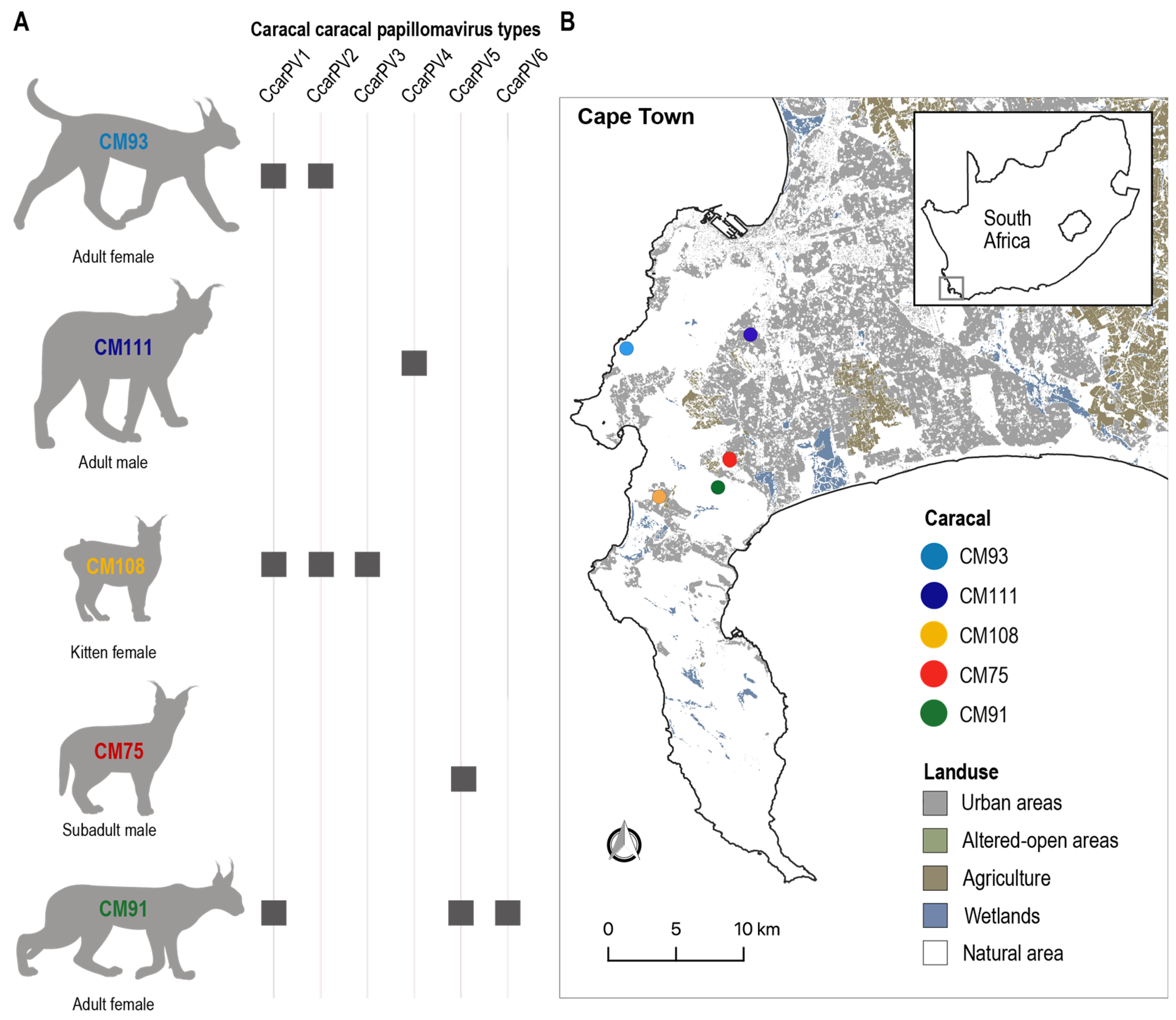
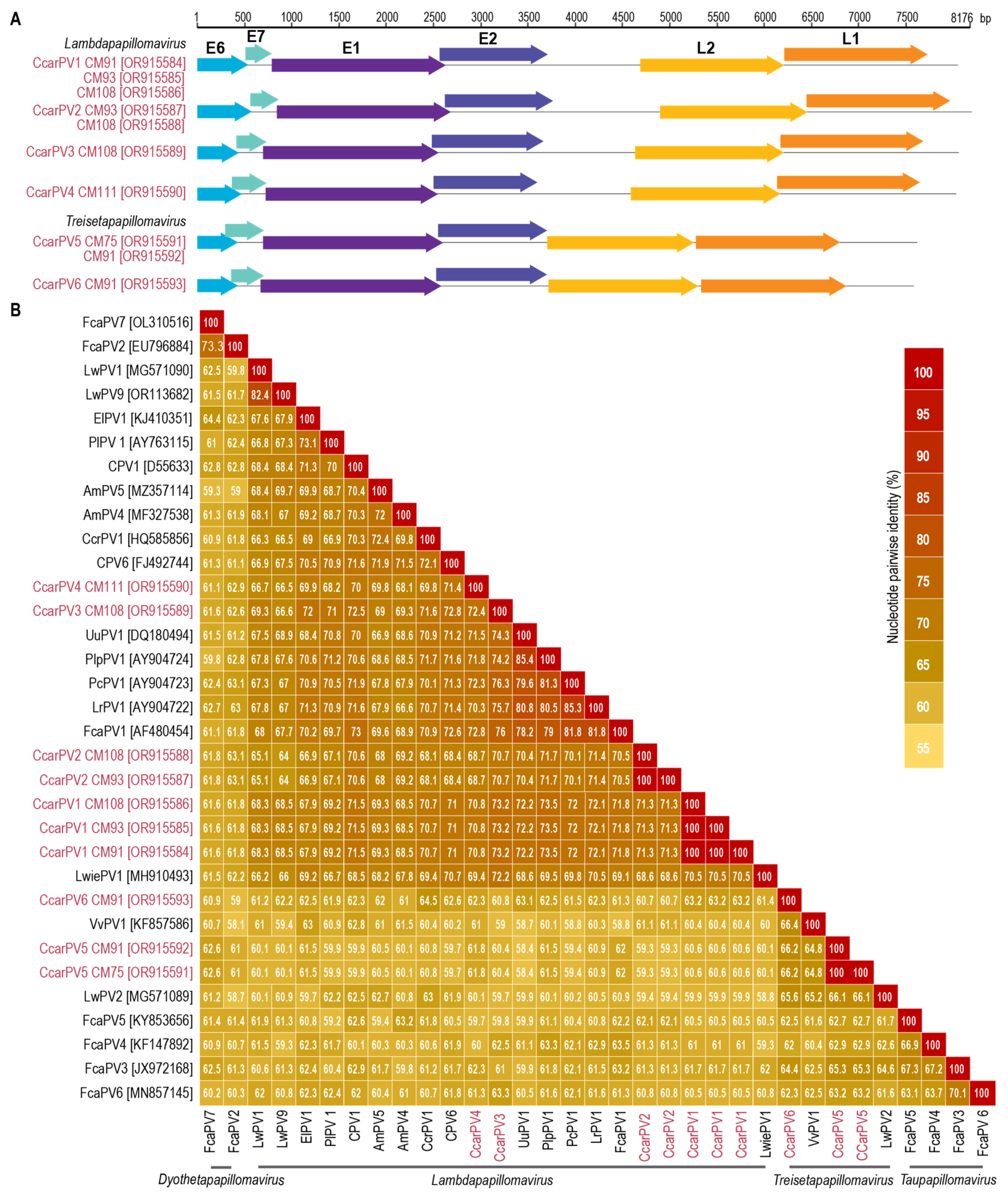
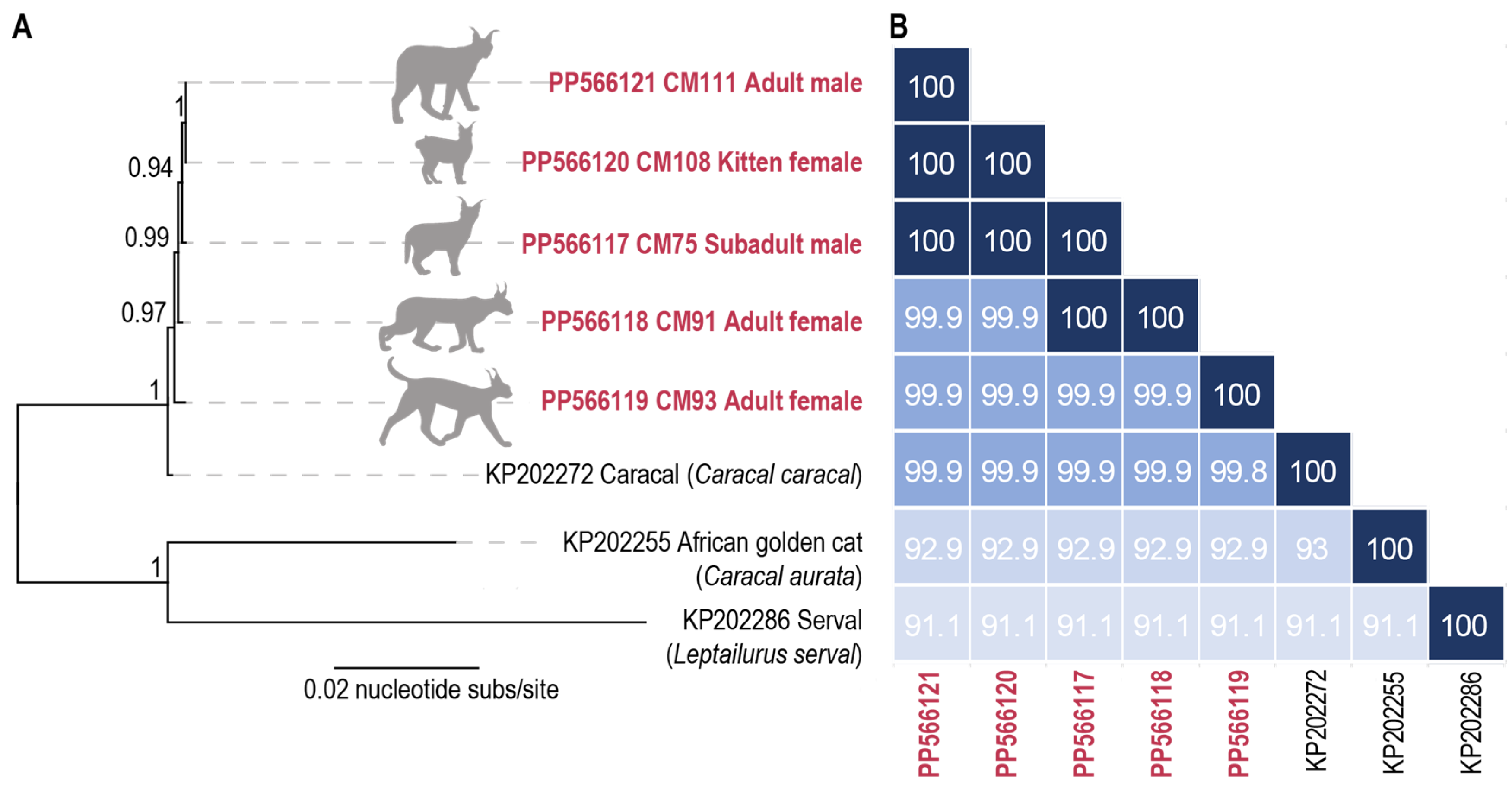
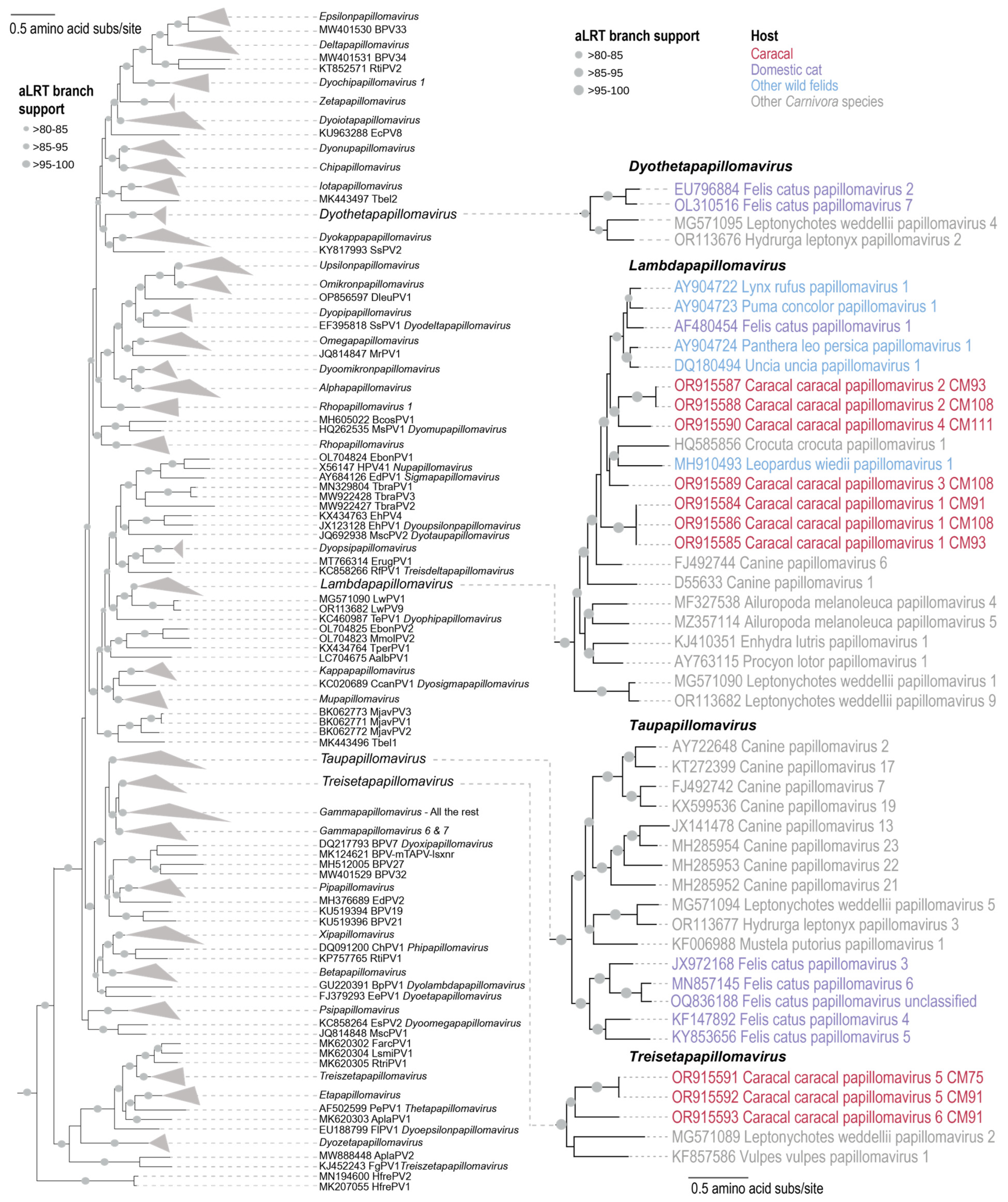
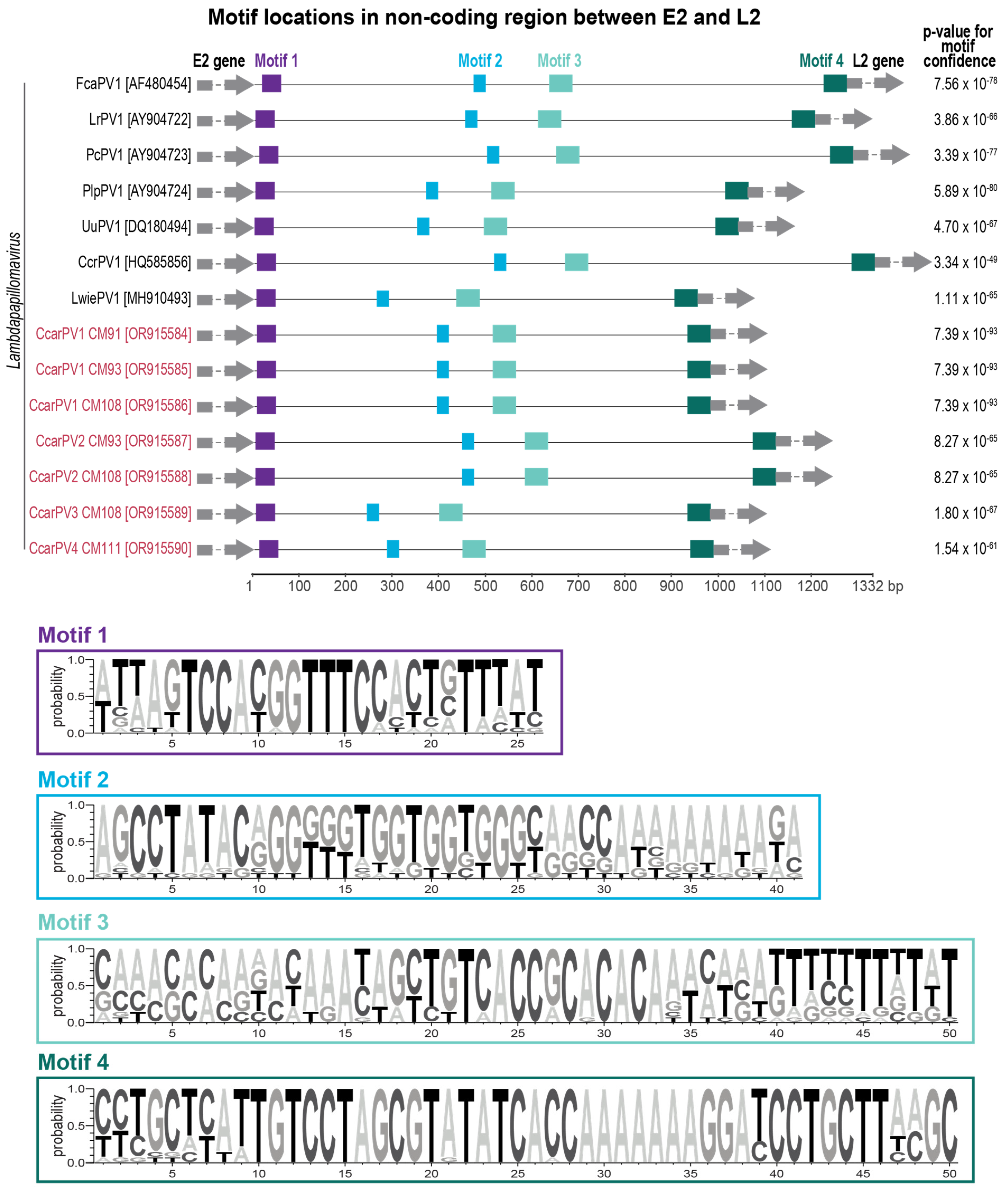

| Type/Species/Genus | Source | Accession Number | Collection Date | Country | Nucleotide Completeness | Isolation Source | Reference |
|---|---|---|---|---|---|---|---|
| Acinonyx jubatus papillomavirus 1 (AjuPV1)/unclassified | Cheetah (Acinonyx jubatus) | MG552617-MG552632, MG552634-MG552638, MG552640-MG552642, MG552644-MG552651, MG552653-MG552668 | 2014/2015 | Namibia | Partial | Oral lesion | [23] |
| Leopardus wiedii papillomavirus 1 (LwiePV1)/unclassified/Lambdapapillomavirus | Margay (Leopardus wiedii) | MH910493 | 2017 | Costa Rica | Complete | Skin lesion | [22] |
| Lynx rufus papillomavirus 1 (LrPV1)/Lambdapapillomavirus 1/Lambdapapillomavirus | Bobcat (Lynx rufus) | AY904722 | N/A | USA | Complete | Oral lesion | [20] |
| Panthera leo persica papillomavirus 1 (PlpPV1)/Lambdapapillomavirus 1/Lambdapapillomavirus | Asiatic lion (Panthera leo persica) | AY904724 | N/A | USA | Complete | Oral lesion | [20] |
| Cheetah | KP760482, KP760483 | 2014 | Namibia | Partial | Oral lesion | [23] | |
| African lion (Panthera leo) | KP760481 | 2014 | Namibia | Partial | Oral lesion | [23] | |
| MG552616 | 2014 | South Africa | Partial | Oral lesion | [23] | ||
| MG552633 | 2014 | South Africa | Partial | Oral lesion | [23] | ||
| MG552639 | 2014 | Namibia | Partial | Oral lesion | [23] | ||
| MG552652 | 2017 | South Africa | Partial | Oral lesion | [23] | ||
| MG552669 | 2017 | South Africa | Partial | Oral lesion | [23] | ||
| Asian tiger (Panthera tigris tigris) | MG552643 | 2015 | South Africa | Partial | Oral lesion | Unpublished | |
| Uncia uncia papillomavirus/unclassified | Snow leopard (Panthera uncia) | OR355483 | N/A | USA | Partial | Skin lesion | [25] |
| MT799783 | 2012 | Mongolia | Partial | Rectal swab | [24] | ||
| Uncia uncia papillomavirus 1 (UuPV1)/Lambdapapillomavirus 1/Lambdapapillomavirus | Snow leopard (Panthera uncia) | DQ180494 | N/A | USA | Complete | Oral lesion | [20] |
| Puma concolor papillomavirus 1 (PcPV1)/Lambdapapillomavirus 1/Lambdapapillomavirus | Puma (Puma concolor) | AY904723 | N/A | USA | Complete | Oral lesion | [20] |
| Bos taurus papillomavirus 14 (BVP14) /Deltapapillomavirus 4/Deltapapillomavirus | Domestic cat (Felis catus) | KP276343 | 2012 | USA | Complete | Skin lesion | [19] |
| Feline sarcoid-associated papillomavirus/unclassified | Domestic cat (Felis catus) | FJ977616 | 2008 | USA | Partial | Skin lesion | [26] |
| Felis catus papillomavirus 1 (FcaPV 1)/Lambdapapillomavirus 1/Lambdapapillomavirus | Domestic cat (Felis catus) | AF480454 | N/A | N/A | Complete | Skin lesion | [11] |
| Felis catus papillomavirus 2 (FcaPV 2)/Dyothetapapillomavirus 1/Dyothetapapillomavirus | Domestic cat (Felis catus) | EU796884 | 2007 | Germany | Complete | Skin lesion | [14] |
| LC612600 | N/A | Japan | Complete | Skin lesion | [27] | ||
| KP868617 | 2014 | Italy | Partial | Skin lesion | [28] | ||
| Felis catus papillomavirus 3 (FcaPV 3)/Taupapillomavirus 3/Taupapillomavirus | Domestic cat (Felis catus) | JX972168 | 2010 | New Zealand | Complete | Skin lesion | [9] |
| KY825188 | 2012 | USA | Complete | Oral lesion | [29] | ||
| KP868618 | 2014 | Italy | Partial | Skin lesion | [28] | ||
| LC333418 | 2013 | Japan | Partial | Skin lesion | [30] | ||
| OP321266 | 2019 | Turkey | Partial | Skin lesion | Unpublished | ||
| HM130736 | 1997 | USA | Partial | Skin lesion | [31] | ||
| Felis catus papillomavirus 4 (FcaPV 4)/Taupapillomavirus 3/Taupapillomavirus | Domestic cat (Felis catus) | KF147892 | 2011 | New Zealand | Complete | Oral lesion | [12] |
| LC333412 | 2013 | Japan | Complete | Skin lesion | [30] | ||
| EF447284 | 2007 | USA | Partial | Skin lesion | [15] | ||
| LC333413 | 2014 | Japan | Complete | Skin lesion | [30] | ||
| MZ357115 | 2020 | China | Partial | Oral swab | [32] | ||
| HM802139 | 2010 | New Zealand | Partial | Skin lesion | [33] | ||
| Felis catus papillomavirus 5 (FcaPV 5)/unclassified Taupapillomavirus/Taupapillomavirus | Domestic cat (Felis catus) | KY853656 | 2016 | New Zealand | Complete | Skin lesion | [10] |
| LC432492, LC432493 | 2017 | Japan | Partial | Skin lesion | [34] | ||
| Felis catus papillomavirus 6 (FcaPV 6)/unclassified Taupapillomavirus/Taupapillomavirus | Domestic cat (Felis catus) | MN857145 | 2020 | Australia | Complete | Skin lesion | [13] |
| Felis catus papillomavirus 7 (FcaPV 7)/unclassified Dyothetapapillomavirus/Dyothetapapillomavirus | Human skin of domestic cat owner | OL310516 | N/A | USA | Complete | N/A | [16] |
| Felis catus papillomavirus unclassified/unclassified/Taupapillomavirus | Domestic cat (Felis catus) | OQ836188 | 2022 | New Zealand | Complete | Skin lesion | [17] |
| OP762604 | 2022 | New Zealand | Partial | Skin lesion | [35] | ||
| Felis catus papillomavirus unclassified | Domestic cat (Felis catus) | FJ222327 | 2008 | New Zealand | Partial | Skin lesion | [36] |
| Felis catus papillomavirus unclassified | Domestic cat (Felis catus) | KX345934 | 2016 | New Zealand | Partial | Skin lesion | [35] |
| Felis catus papillomavirus unclassified | Domestic cat (Felis catus) | ON017788 | 2022 | New Zealand | Partial | Skin lesion | [35] |
| Felis catus papillomavirus unclassified | Domestic cat (Felis catus) | GU724683 | 2009 | New Zealand | Partial | Oral lesion | [37] |
| Human papillomavirus 182 (HPV182)/Betapapillomavirus 2/Betapapillomavirus | Domestic cat (Felis catus) | GQ916646 | 2001 | USA | Partial | N/A | [38] |
| Human papillomavirus 9 (HPV9)/Betapapillomavirus 2/Betapapillomavirus | Domestic cat (Felis catus) | EF608232 | N/A | New Zealand | Partial | Skin lesion | [39] |
| Animal ID | Sampling Date | Age Class | Sex | Cause of Mortality | Latitude | Longitude | Caracal Caracal Papillomavirus (CcarPV) [Accession Number] |
|---|---|---|---|---|---|---|---|
| CM93 | 23 April 2022 | Adult | Female | Hit by car | −34.009083 | 18.348333 | CcarPV1 [OR915585] CcarPV2 [OR915587] |
| CM108 | 18 May 2023 | Kitten | Female | Disease or pesticides | −34.1066937 | 18.3710802 | CcarPV1 [OR915586] CcarPV2 [OR915588] CcarPV3 [OR915589] |
| CM75 | 1 March 2021 | Subadult | Male | Hit by car | −34.083054 | 18.427006 | CcarPV5 [OR915591] |
| CM91 | 10 April 2022 | Adult | Female | Hit by car | −34.101580 | 18.417405 | CcarPV1 [OR915584] CcarPV5 [OR915592] CcarPV6 [OR915593] |
| CM111 | 2 June 2023 | Adult | Male | Poached | −34.002037 | 18.445959 | CcarPV4 [OR915590] |
Disclaimer/Publisher’s Note: The statements, opinions and data contained in all publications are solely those of the individual author(s) and contributor(s) and not of MDPI and/or the editor(s). MDPI and/or the editor(s) disclaim responsibility for any injury to people or property resulting from any ideas, methods, instructions or products referred to in the content. |
© 2024 by the authors. Licensee MDPI, Basel, Switzerland. This article is an open access article distributed under the terms and conditions of the Creative Commons Attribution (CC BY) license (https://creativecommons.org/licenses/by/4.0/).
Share and Cite
Kraberger, S.; Serieys, L.E.K.; Leighton, G.R.M.; De Koch, M.D.; Munday, J.S.; Bishop, J.M.; Varsani, A. Two Lineages of Papillomaviruses Identified from Caracals (Caracal caracal) in South Africa. Viruses 2024, 16, 701. https://doi.org/10.3390/v16050701
Kraberger S, Serieys LEK, Leighton GRM, De Koch MD, Munday JS, Bishop JM, Varsani A. Two Lineages of Papillomaviruses Identified from Caracals (Caracal caracal) in South Africa. Viruses. 2024; 16(5):701. https://doi.org/10.3390/v16050701
Chicago/Turabian StyleKraberger, Simona, Laurel E. K. Serieys, Gabriella R. M. Leighton, Matthew D. De Koch, John S. Munday, Jacqueline M. Bishop, and Arvind Varsani. 2024. "Two Lineages of Papillomaviruses Identified from Caracals (Caracal caracal) in South Africa" Viruses 16, no. 5: 701. https://doi.org/10.3390/v16050701





